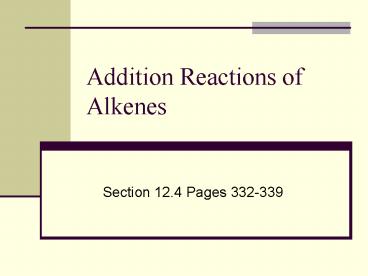Addition Reactions of Alkenes - PowerPoint PPT Presentation
Title:
Addition Reactions of Alkenes
Description:
Addition Reactions of Alkenes Section 12.4 Pages 332-339 Addition Reaction Addition of two atoms or groups of atoms to a double bond. R can be carbon or hydrogen. – PowerPoint PPT presentation
Number of Views:144
Avg rating:3.0/5.0
Title: Addition Reactions of Alkenes
1
Addition Reactions of Alkenes
- Section 12.4 Pages 332-339
2
Addition Reaction
- Addition of two atoms or groups of atoms to a
double bond. - R can be carbon or hydrogen.
3
Types of Addition Reactions
- The major alkene addition reactions include
- Addition of hydrogen (H2) hydrogenation
- Addition of halogens (Cl2 or Br2) halogenation
- Addition of water (H2O) hydration
- Addition of hydrogen halides (HBr or HCl)
hydrohalogenation - Note Double bond becomes a single bond.
4
Hydrogenation Adding H2
- Double bond is broken
- H atom added to both sides of double bond
- Platinum, palladium, or nickel catalyst required
- Heat and/or pressure may also be needed
5
Examples of Hydrogenation
- Hydrogenation of 1-propene to propane
- Hydrogenation of trans-2-butene
6
YOU TRY THESE!
- Write hydrogenation reactions for
- 1-pentene
- 2-methyl-2-butene
- ethene
7
Halogenation Adding Br2 or Cl2
- This reaction occurs easily and does not require
a catalyst.
8
Examples of Halogenation
- Bromination of 1-propene to form
1,2-dibromopropane - Chlorination of trans-2-butene to form
2,3-dichlorobutane
9
YOU TRY THESE!
- Write halogenation reactions for
- 1-pentene with bromine
- 2-methyl-2-butene with chlorine
- Ethene with chlorine
10
Hydration Addition of H2O
- Requires a trace of acid (H) as a catalyst
- The product is an alcohol
- Markovnikovs rule applies
11
Markovnikovs Rule
- A mixture of products is formed when an
unsymmetrical alkene is hydrated. - One product is always favored over the other.
- Vladimir Markovnikov came up with a rule to
determine the major product formed. - The carbon of the carbon-carbon double bond that
originally has more hydrogen atoms receives the
hydrogen atom being added. - The rich get richer.
12
Example of Markovnikovs Rule
- Hydration of 1-propene to form 2-propanol (major)
and 1-propanol (minor)
13
YOU TRY THESE!
- Write the hydration equation for each of the
following molecules. Indicate the major and
minor products for the reactions where
applicable. - 1-pentene
- 2-methyl-2-butene
- ethene
14
Hydrohalogenation Adding HCl or HBr
- Follows Markovnikovs rule
15
Examples of Hydrohalogenation
- Hydrobromination of 1-propene to form
2-bromopropane (major) and 1-bromopropane (minor)
16
YOU TRY THESE!
- Write the hydrohalogenation equation for each of
the following molecules. Indicate the major and
minor products for the reactions where
applicable. - 1-pentene with HCl
- 2-methyl-2-butene with HBr
- Ethene with HCl

